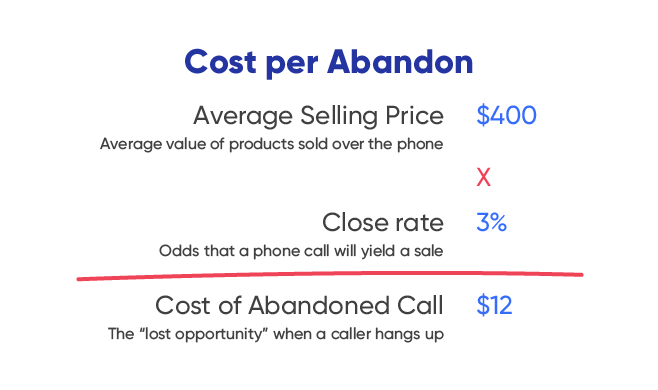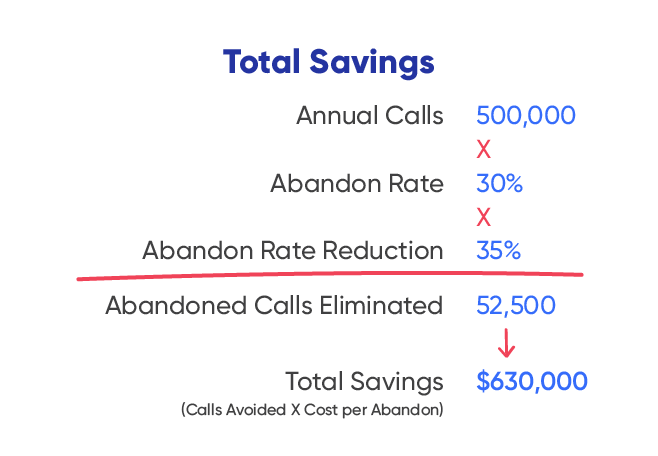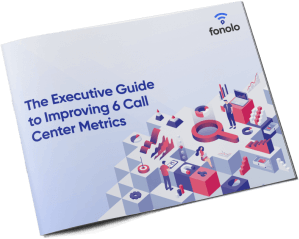Lowering call abandonment rates in contact centers is one of the most powerful performance levers available to call center managers. It’s also what Fonolo Call-Backs do best. Reducing abandonment rates is a primary benefit of our call-back software and we’ve helped dozens of companies improve their KPIs by solving their abandonment rate problems. So, we’re hoping you’ll forgive us for making this piece long and detailed.
This guide will walk you through everything you need to know in order to understand, measure, and reduce call abandonment in your contact center.
What is an Abandoned Call?
The definition of an abandoned call in a call center is a call where the caller hangs up before they speak to a customer support agent.
TIP:
Most contact center software will generate a Call Detail Record (CDR). This feature displays data for each incoming call, including time before the customer abandoned the call.
The more successful your call center is – that is, the more calls you get – the more likely you are to face increased hold times. That’s when increased abandoned rates become a problem.
What is Call Abandonment Rate?
Call abandonment rate (often called abandon rate) is a call center metric used to measure the percentage of calls that are abandoned before they reach a customer service agent. To calculate the abandonment rate, divide the number of abandoned calls by the total number of calls, and then multiply by 100 to get the number as a percentage.
Why is Call Abandonment Rate Important?
Call abandonment speaks directly to customer dissatisfaction and the negative impact it has on customer loyalty. As the experts point out, it’s less expensive to keep existing customers happy than it is to acquire new ones.

How to Eliminate Hold Time in Your Call Center
Abandonment leads to higher repeat calling, which lowers both first call resolution and, of course, customer satisfaction. As you would expect, abandon rate grows with average speed of answer (ASA). The longer callers are on hold, the more likely they are to give up.
Customers can only hear “… your call matters to us …” so many times before they lose patience and end the call.
How Does Abandonment Rate Affect Customer Satisfaction?
Benchmarks are important, but it’s much more important to understand what’s acceptable for your customers than to rely on industry averages. If you are concerned about NPS and CSAT scores, eliminating hold time should be a priority. One analysis comparing a company’s net promoter score to the number of Twitter complaints about being stuck on hold found a direct correlation between the two.
Of those who abandon, a percentage will take their business elsewhere (or they’ll remember the experience when evaluating their next purchase).
Many who abandon will dial again and again, escalating queue times with each call. It’s not hard to see the correlation between the abandonment rate and customer retention.
Every contact center worth its salt already tracks abandon rates as well as other KPIs that matter. The real question is what to do with that data? What’s an acceptable abandon rate for your organization, and what can you do about it?
Abandonment is not entirely under the control of the contact center, after all. While you can affect queue times, many other factors are beyond your control. For example, the tolerance level of individual callers, service or marketing initiatives causing traffic to spike, time of day issues and more.
Why Do Callers Abandon Calls?
You’ll need to look at your own metrics to know for sure, but there are common reasons callers tend to abandon calls. They include:
- Long hold times
- Poor IVR system
- Poorly trained agents
- Technical problems with the call
- Lack of communication
Distinguishing Between Call Types and Intent
Another key to understanding why customers abandon calls is differentiating between the types of calls your customers are making.
Typically, customers calling for technical support with a problem are much less likely to hang up than those making a call to a sales line.
It may help you to split your abandonment rate into groups, depending on caller intent. This will help you identify which areas of the business are the target of these calls, as where it might be most profitable to direct your energy.
Changing the Definition of an Abandoned Call
This one seems like cheating or massaging the figures, but it’s far from it. There are many pitfalls when measuring abandonment rate in a call center — one of them is too broad a definition of abandoned calls.
Here are some questions to ask yourself, to assess whether your criteria is fair:
- Are any of these calls placed outside of business hours?
- What if the call was actually a misdial by the customer?
- What if their battery or network failed?’
How Much Does an Abandoned Call Cost?
To assign ROI based on reduction in abandonment rate, you need to assign a dollar value to an abandoned call in your call center. In a sales scenario this is straightforward: it’s the “opportunity cost” of each missed conversation between an agent and a caller.
Here’s an example of that math for fictional company “ExampleCo.”

Some notes on cost per abandoned call:
- Depending on your product or service, you could substitute a number representing “Lifetime Customer Value” for the “Average Selling Price” number on the top line.
- In a scenario other than sales, it’s harder to get that top-line number, however, companies do come to us with a number based on their own internal processes.
- Cost per Abandon has a very wide range. We’ve seen values as low as a few dollars and as high as $120.
Calculating Your Savings
Once you have the cost of an abandoned call for your call center, the next question is, how many abandons can be avoided. Case studies suggest that 35% is a reasonable benchmark for the “Abandon Rate Reduction Factor.” Let’s choose that, and continue working through our example:

4 Ways to Reduce Abandoned Calls in a Call Center
Now that we’ve discussed how to identify the causes and costs of high abandonment rates let’s take a look at how to improve things.
1. Adjust schedules and hire more agents
One obvious way to lower your abandonment rate is to lower hold time by hiring more agents, though staffing up is expensive and therefore not necessarily the place to start. Many abandonment rate problems (and other problems, too) can be fixed by adjusting your staffing schedules based on volume.
Either way, both solutions are less expensive than having to acquire new customers! According to CallCenterHelper, 6/10 customers have ditched a company because its telephone customer service has been so bad.
So, if you have the budget, you can just keep adding agents until your abandonment rate shrinks down to your target level. Keep in mind that if you always staff to the peak volume, you will have a lot of excess agent capacity at other times. That makes this model inefficient and expensive.
2. Learn from your data
If you’re not regularly reviewing call detail reports, you should be. Know the peak periods when your customers are contacting you, how long they’re waiting (ASA) and how long it takes to resolve those calls – average handle time.
And, if customers are abandoning the call, find out how long they’re waiting before they hang up. Call detail reports provide you with a wealth of information and insight into your calls — including the ones that never got answered.
When you know who abandoned a call, when they called you, and how long they waited before hanging up, you can make informed decisions on how to resolve the situation.
3. Offer other channels of communication
Eighty-eight per cent of all organizations are delivering multi-channel and omnichannel service experiences. And that’s a good thing because studies show that the average consumer expects to be able to reach a company across at least 10 different channels!
By offering support over other channels, and self-service options, you empower your customers and remove some of the burden on your call center. You should see fewer abandoned calls as a result.
Be careful about taking resources away from the voice channel to support new channels though. Research shows that the live agent conversations are still the most critical for maintaining customer loyalty.
4. Offer customers a call-back
One of the single best ways to reduce abandonment is to offer customers a call-back as an alternative to waiting on hold. Call-backs smooth out call volumes while lowering abandonment rate. Customers save time, companies save money.
Call-backs can also radically improve the customer experience and reduce cost-per-call. According to Forrester, “The option to hold their place in the queue and go on to do something else is highly appealing, with 75% stating a preference for it.”
Why take the risk that your customers are going to abandon after 30, 60 or 90 seconds on hold? Offer to call them back and earn their loyalty for good.
A study by Contact Babel showed that 32% of contact centers experienced fewer abandoned calls after call-backs were added. At Fonolo, we’ve witnessed this effect many times.
Get the Most Out of Your Call-Backs
As we’ve discussed, call-backs reduce call abandonment by allowing callers to keep their place in line, without staying on hold. Once callers switch to this mode of waiting, they are much less likely to abandon. That’s because the mental effort required from the caller is much reduced. (For companies focusing on “customer effort score”, this is a good point to keep in mind.)
Consider the impact of offer timing
The time-’til-offer or TTO is the amount of time a caller spends in the queue before hearing a call-back offer. It is quite important because it impacts both the offer rate and the take-up rate.
It impacts the offer rate because as TTO gets longer, a larger fraction of callers will abandon or connect with an agent before hearing the offer. (In the extreme, if TTO is greater than your longest queue time, then the offer rate is zero.)
TTO impacts the take-up rate because of the psychology of callers. Some fraction of callers will take an offer that is made immediately while others will opt to “wait it out”. But after a few minutes on hold, callers are more likely to take that option, so the take-up rate grows. After a while, this effect flattens out.
Take-up also increases by making multiple offers for the call-back. In fact, this is the best way to maximize the overall call-back rate. (If you’re assessing vendors for a call-back solution, make sure the ability to make multiple offers once a caller is in the queue is on the feature list.) Changing TTO is an easy “lever” to adjust and has a big impact on the performance of your call-back deployment.
5 Common Pitfalls When Measuring Abandonment Rate
There are several nuances in calculating abandonment rate. Ignoring these five pitfalls could leave you with a misleading result.
Pitfall 1: Treating All Hang-Ups as Abandoned Calls
It is common practice to exclude very short calls from the abandon rate. The logic behind this is that someone might have dialled the wrong number and didn’t realize the mistake until after the call was connected. But how short is too short? There is no universally accepted number.
One way to find a good “short call” cut-off time is to look at a histogram of call durations. For example, consider the popularity of calls that are 0-5 seconds, 5-10 seconds, etc. You may see a demarcation between mistaken calls and calls with true intent.
This blog post illustrates four different options for dealing with short calls, and offers visual representations of popular call center equations.
Pitfall 2: Ignoring Short Abandons
Another problem arises when the threshold for “short calls” is too long. This can sweep legitimate abandons under the rug. Call centers often succumb to this temptation in an effort to meet management objectives, but that’s a losing game.
Pitfall 3: Including Self-Serve or Navigation Time
If a caller hangs up while going through a self-serve process that should not be counted as an abandoned call, but rather count against the success rate of that process.
The reason to separate these numbers is that an abandoned IVR-based process indicates a different problem from an abandoned call that was in the queue. The former might be due to unclear prompts, or too lengthy a process. The latter is almost always due to excessive hold time.
TIP:
A universal rule covering these first three pitfalls is: Once the caller indicates the intent to reach an agent, the call should end in success (an agent conversation) or count as abandoned.
Pitfall 4: Not Adjusting for Call-Backs
One way to lower your abandonment rate is to offer callers the option of a call-back instead of waiting on hold. Usually, this offer sounds like, “Press 1 to get a call-back from the next available agent”. If the caller takes this option, the current call will end, but clearly this should not be counted as an abandon.
Depending on the call-back solution used and the automatic call distribution (ACD), there should be a way to distinguish these calls from true abandons. For example, with Fonolo deployed on an Avaya call center, these calls appear as “RONAs” (Remote Outflow, No Answer”) on the call reports.
Pitfall 5: Pursuing an Abandon Rate that is Too Low
It’s a worthy goal to eliminate abandoned calls as much as possible, but in a system as complicated as a call center, every attempt to optimize for one variable impacts other variables. Keep the big picture in mind and make sure you spend your time and budget on efforts that deliver the biggest boost to customer satisfaction.
As your abandon rate gets lower, there are diminishing returns. Below a certain point, a further reduction will not improve customer satisfaction. There is a terrific exploration of this effect on MetricNet.com.

Why Do Costs Go Up as Abandon Rates Go Down?
More agent headcount is required to achieve lower abandonment rates. And as the headcount increases, so does the cost of support. Here’s an example:
Let’s say a service desk with 10 full time agents has an average abandonment rate of 8%.
Reducing the abandonment rate to 4% would require a full-time agent headcount of approximately 13. That’s a 30% increase in headcount, for a four percentage point decrease in abandonment rate.
Is that worth it? Apparently not, because the added headcount increases costs significantly, but produces very little benefit in terms of higher customer satisfaction.
7 Ways to Create a Better Queuing Experience
There’s only so much you can do to reduce hold time. At some point, you have to think about your customer’s queueing experience, too.
One way to stop people from hanging up is to make the queueing experience itself more enjoyable. Or at least not quite so painful. Communicating with your customers while they’re waiting on hold can improve your call abandon rates. Here are some ways to switch it up create a better customer experience:
1. Increase the initial ring time
You could try increasing the ring time prior to connecting callers to your IVR or offering a call-back. It may sound counterintuitive but it’s a great way of using psychology to buy a few extra seconds.
The average phone rings for about 20 seconds before going to voicemail — and most people are programmed to accept this without question. Try upping the ring time to 10-20 seconds before connecting callers to an automated message and see how this impacts your abandoned call numbers.
This is a pretty low-risk strategy that can buy you a few extra seconds. Over thousands of calls, this could save a few hours!
2. Keep customers informed
Customers appreciate honesty — even if they don’t like the message. If hold-times are an issue, consider preparing customers by placing a message in the IVR or ACD. You can share the estimated wait time or warn about high call volume.
But be warned: repeating a vague recorded message that “your call is important to us” is more likely to annoy customers, and they will perceive the wait to be longer than it is. And if you’re playing this all the time, it will have little impact. It may even be increasing abandoned calls.
If you can’t estimate a wait time, tell customers what number they are in the queue, so at least they perceive some progress.
When peak times are predictable, another option is to drive callers to call back during periods of lower call volume. For example, a message might say, “… we normally experience higher than normal call volume the first week of each month …”.
At first, this approach can encourage call avoidance. Over the long term it can help lower handle times and abandon rates by encouraging customers to call during off-peak periods.
3. Change your welcome message
Is it possible that your welcome message is actually putting people off? If your abandoned call curve shows a sharp drop-off at the end of your welcome message, it’s probably not a coincidence.
Experiment with your welcome message. Maybe some extra information would help to reduce abandoned calls. You could use the opportunity to answer callers’ questions in advance or offer another method of contact.
4. Change your hold music
Believe it or most people actually like to listen to music while they’re on hold. But your particular musical tastes could be turning them off and encouraging them to hang up, instead of vibing out while they wait. Once again, your abandoned call curve will be able to tell you which tracks on your on-hold playlist are trash, and which are gold.
Another great way of getting feedback on your hold music is heading to social media, and Twitter in particular. For more on this one, check out this piece on What Customers Really Think of Your Hold Music.
5. Change queue message frequency
Another consideration should be how frequently you’re playing recorded messages in your IVR. You may be irritating callers unnecessarily.
Remember, most people prefer to do something else while they’re waiting on hold. Hold music is a great, gentle reminder that doesn’t draw their attention away from whatever else they’re doing.
If you can, experiment with the interval length between recorded messages (and keep an eye on your abandoned call curve) so you can find the perfect length of time between messages.
6. Reduce average handle time
Lowering the amount of time your agents spend on each call will help your call center serve more customers overall. If your agents are adept at anticipating customer needs and efficient in solving their issues, they can handle higher call volumes more easily.
7. Fix abandoned calls at the root
Why are so many customers calling? Is this something that you can fix outside of the call experience?
If you’re consistently struggling with high call volume, long wait times, and abandoned calls, the biggest single impact you can have is to solve the issue that’s causing high call volume in the first place.
Your customer support team won’t typically have the resources or access to instigate those changes, but you can add a lot of value to your business by sharing that feedback with the people and departments who can make those changes.

The Executive Guide to Improving 6 Call Center Metrics
Measuring and improving call center metrics can be a pain point for executives. Download our free guide to help you improve 6 key call center metrics.
